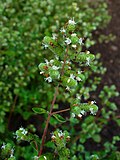Za'atar (/ˈzɑːtɑːr/ ZAH-tar; Arabic: زَعْتَر, IPA: [ˈzaʕtar]) is a Levantine culinary herb or family of herbs. It is also the name of a spice mixture...
28 KB (2,919 words) - 19:32, 25 October 2024
spellings, is a popular Levantine food consisting of dough topped with za'atar, cheese, or ground meat. It can be sliced or folded, and it can be served...
7 KB (665 words) - 09:15, 4 November 2024
is a preferred primary ingredient in the spice mixture za'atar. The plant may be called za'atar by association with its use in an herb-spice mixture. In...
10 KB (1,043 words) - 18:07, 17 October 2024
spice, particularly in combination with other spices in the mixture called za'atar. The word originally comes from hebrew - סמק.... ....then through the Aramaic...
4 KB (421 words) - 08:23, 29 April 2024
refers to thyme, or za'atar in Arabic – a common Middle Eastern herb in Levantine Arabic cuisine used notably in preparation of za'atar manakeesh and other...
6 KB (544 words) - 11:05, 12 October 2024
It is often used in herb combinations such as herbes de Provence and za'atar. The flowering leaves and tops of marjoram are steam-distilled to produce...
13 KB (1,322 words) - 15:01, 10 November 2024
widely used as symbols for the Palestinian nation. Other plants including za'atar (thyme) and handal (colocynth) and traditional Palestinian crafts such...
12 KB (1,421 words) - 12:28, 10 August 2024
salads, kebab and lahmajoun. Rhus coriaria is used in the spice mixture za'atar. During medieval times, primarily from the thirteenth to fifteenth centuries...
25 KB (2,501 words) - 21:18, 10 November 2024
Manakish (مناقيش)—a pizza-like flatbread garnished with minced meat, thyme or za'atar, commonly eaten for breakfast or dinner Mfarakeh (مفركة)—an Arab dish made...
15 KB (1,596 words) - 16:06, 9 October 2024
Retrieved 2 July 2016. Malouf, Greg and Lucy Malouf (1999). Artichoke to Za'atar: Modern Middle Eastern Food. University of California Press. p. 278. ISBN 9780520254138...
7 KB (630 words) - 20:25, 8 November 2024









